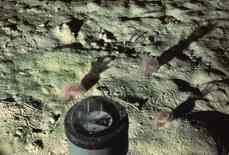|
Early theories on the deep-sea biodiversity
assumed that the sea floor presented a very uniform environment,
with only a small number of species living on it.
That changed with Hessler and Sanders discovery
of surprisingly high species diversity in the deep sea, 40
years ago, which inspired a period of intense ecological research
in the largest and least known of Earth's ecosystems.
It has become apparent that the deep sea experiences
seasonality and that organisms living there respond to this.
It has been suggested that major changes that have been observed
in deep-sea benthic communities in the world's ocean reflect
organic carbon supply in the major biogeochemical provinces.
More recently, dramatic changes in benthic communities have
been ascribed to changes in the upper water column and in
the quality of organic matter reaching the seafloor.
Most organisms on the deep sea floor are deposits feeders,
which depend on the downward flux of organic matter (OM) for their energy
and essential nutrients.
 |